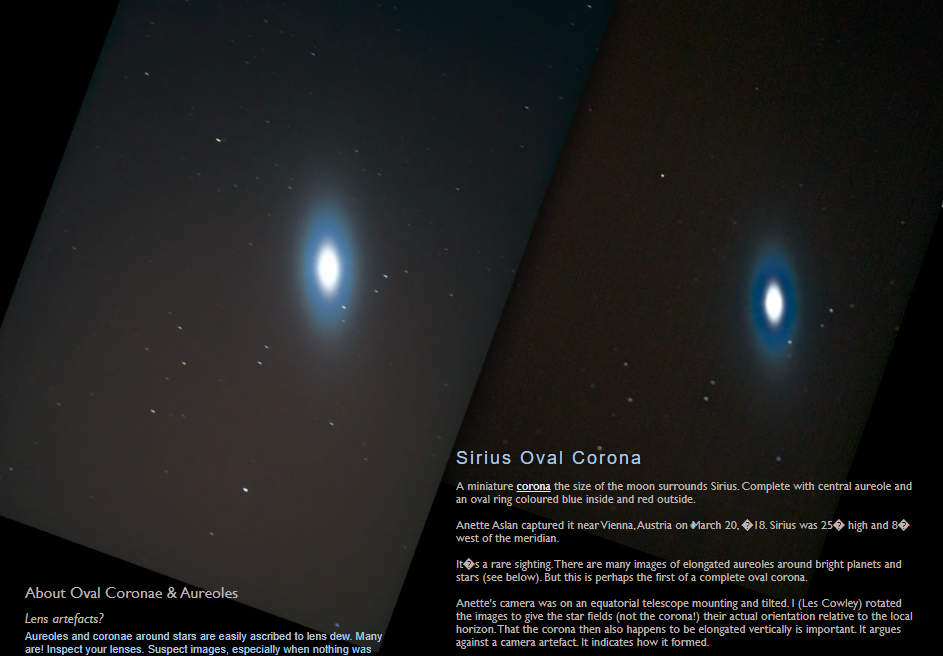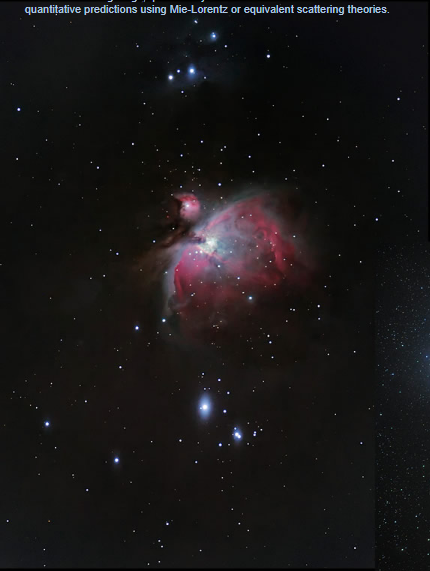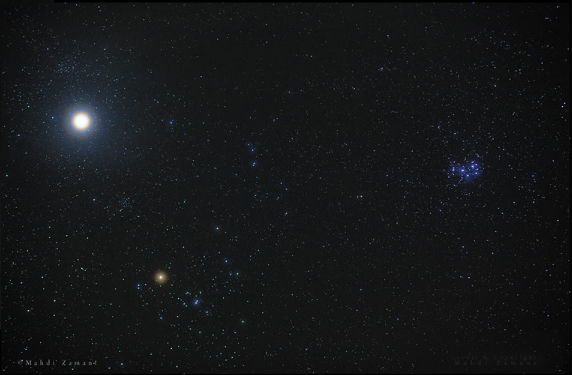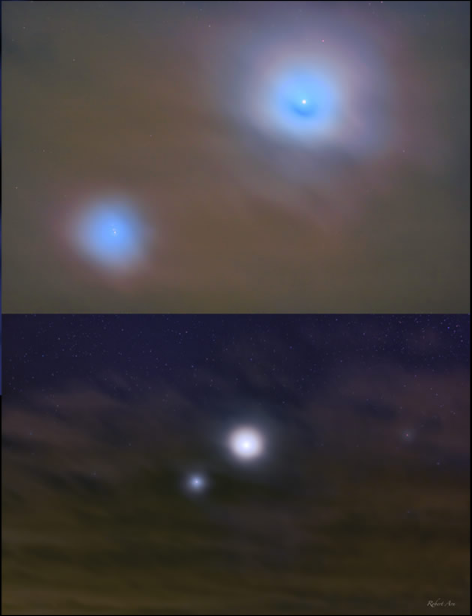Oval aureoles and coronae around stars and planets
Oval Aureoles and Coronae: A Phenomenon of Atmospheric Optics
Have you ever gazed at the night sky and noticed intriguing oval shapes surrounding stars and planets? These mesmerizing formations are known as oval aureoles and coronae, captivating optical phenomena that add a touch of mystique to our celestial observations. While elongated aureoles around bright celestial bodies have been documented before, capturing a complete oval corona has been a rarity. However, recent sightings have shed light on the formation and nature of these captivating oval structures.
The Enigmatic Oval Corona of Sirius
One exceptional sighting of an oval corona occurred near Vienna, Austria, on March 20, 2018. Anette Aslan managed to capture a stunning image of a miniature corona enveloping Sirius, the brightest star in the night sky. The corona featured a central aureole and a distinct oval ring with blue coloring on the inside and red on the outside. What makes this sighting truly remarkable is that it is believed to be the first documented instance of a complete oval corona. The orientation of the elongated corona, both vertically and horizontally, provides evidence against any camera artifact and offers valuable insights into its formation.
Exploring Oval Coronae & Aureoles
While some aureoles and coronae around stars and planets can be attributed to lens dew or other optical artifacts, there is a growing body of evidence supporting the existence of genuine oval formations. Reports of aureoles around bright planets date back to 2001, with sightings in Finland by Matti Lamminen and others. In 2009, the first observations of oval aureoles were reported by OPOD (Optics Picture Of the Day). These ovals consistently displayed vertical elongation, leading to the development of a hypothesis regarding their formation. Subsequent observations have provided further support for this hypothesis.
Unveiling the Mechanism behind Oval Coronae
The formation of aureoles and coronae, both circular and oval, is attributed to a phenomenon called diffraction. When light waves interact with cloud water droplets, ice crystals, or airborne pollen grains, they scatter and interfere with each other, creating a pattern of colored rings around a central bright aureole. While spherical particles typically produce circular coronae, non-spherical objects like pollen grains can give rise to oval coronae. Elongated pollen grains, when aerodynamically aligned, generate distinct oval formations. However, oval coronae have also been observed in high cirrus clouds, outside the pollen season, indicating the presence of other factors.
The Role of Ice Crystals in Oval Coronae Formation
To explain the formation of oval coronae, we must consider the role of elongated objects in the atmosphere. Oval coronae and aureoles require the presence of horizontally elongated objects, such as non-spherical pollen grains or ice crystals. Through measurements of the star field surrounding Anette's corona, it was estimated that the particles responsible for the oval formation were approximately 200 microns across. Ice crystals, which can reach sizes up to 1000 microns (1mm), are prime suspects in this size range. Specifically, plate crystals and hexagonal columns with horizontal orientations are likely culprits.
Suspects: Plate Crystals and Horizontal Column Crystals
Plate crystals, when viewed directly upwards in a cirrus cloud, appear as tiny hexagons and are not conducive to oval corona formation. However, when the same cloud is observed closer to the horizon (between 10 to 30 degrees above), the plate crystals adopt a more edge-on orientation, resulting in horizontal elongation suitable for vertical oval coronae. Horizontal column crystals, on the other hand, present a different scenario. When looking at a cloud of columns, one would observe sticks aimed in various directions. The resulting corona is a combination of circular patterns from individual crystals. Closer to the horizon, some crystals appear end-on as dots, while others display varying lengths of horizontal sticks. The average orientation of these crystals creates a horizontally extended corona, resembling a vertical oval.
Predictions and Observations
Based on the hypothesis put forth by OPOD in 2009, it was predicted that vertically elongated coronae and aureoles would be observed near the horizon, while circular formations would be predominant at higher altitudes. This prediction was confirmed by a simultaneous sighting of Venus and Jupiter, where the vertical oval corona around Venus and the circular aureole around Jupiter were captured within minutes of each other. These observations align with the expected behavior of oval coronae formed by large plate crystals or columns. Further quantitative predictions can be made using scattering theories such as Mie-Lorentz.
Exploring the Celestial Oval Aureoles and Coronae
The captivating oval formations are not limited to Sirius, Venus, and Jupiter alone. They have also been observed around stars near the Orion Nebula, adding an extra layer of intrigue to our understanding of atmospheric optics. While longer exposures reveal oval aureoles even around fainter stars, further research and observations are necessary to unravel the full extent and intricacies of these enigmatic phenomena.
As we delve deeper into the world of atmospheric optics, we uncover the secrets behind these captivating oval aureoles and coronae. The interplay between non-spherical particles, such as pollen grains and ice crystals, and the diffraction of light waves creates awe-inspiring patterns in the night sky. With continued research and observation, we can expand our knowledge and appreciation of these mesmerizing optical phenomena that add wonder to our celestial experiences.

Sirius Oval Corona
A miniature corona the size of the moon surrounds Sirius. Complete with central aureole and an oval ring coloured blue inside and red outside.
Anette Aslan captured it near Vienna, Austria on March 20, �18. Sirius was 25� high and 8� west of the meridian.
It�s a rare sighting. There are many images of elongated aureoles around bright planets and stars (see below). But this is perhaps the first of a complete oval corona.
Anette's camera was on an equatorial telescope mounting and tilted. I (Les Cowley) rotated the images to give the star fields (not the corona!) their actual orientation relative to the local horizon. That the corona then also happens to be elongated vertically is important. It argues against a camera artefact. It indicates how it formed.
Top images ©Anette Aslan Text ©2018 Les Cowley
About Oval Coronae & Aureoles
Lens artefacts?
Aureoles and coronae around stars are easily ascribed to lens dew. Many are! Inspect your lenses. Suspect images, especially when nothing was noticed by eye.
Yet some are real
Aureoles around bright planets were reported in Finland by Matti Lamminen and others as early as 2001. There is now a body of reported sightings.
Oval observations are perhaps more recent. OPOD's first reports were in 2009. The ovals were all vertically elongated and in 2009 OPOD hypothesised a mechanism for their formation. Later observations support it.
OPOD has several images of oval and non-oval aureoles and one or two coronae around Venus, Jupiter and stars. Thumbnail links below.
Their formation by diffraction
Diffraction forms aureoles and coronae. Cloud water droplets, ice crystals and airborne pollen grains scatter light waves. The scattered waves interact (interfere) to give a pattern of coloured rings around a central bright aureole.
That's the easy bit. But how do the oval ones form?
Pollen
Spherical particles make circular coronae. Some pollen grains are famously non spherical and � when aerodynamically aligned � produce oval coronae. At right are elongated pollen coronae/aureoles around Venus and the Moon. So far so good but other ovals were obviously formed in high cirrus out of the pollen season.
Oval coronae need:
Oval coronae and aureoles need elongated objects. Non-spherical like pollen grains. Vertical ovals need horizontally elongated objects. Size matters. I calculate from measurements of the star field that Anette�s corona came from particles around 200 micron across. Other oval aureoles yield similar particle sizes.
Suspects
There is only one suspect in that size range. Ice crystals. They can be up to 1000 micron (1mm) across. They are variously oriented. Plates with their large hexagonal faces horizontal are possible culprits. So are hexagonal columns with their long axes horizontal.
Suspect 1 - Plate crystals
Look directly upwards at a cirrus cloud full of plate crystals. With ultra telescopic vision you see a multitude of tiny hexagons. No good for oval coronae, they would produce circular ones.
But look at the same cloud closer to the horizon, say 10 to 30 degrees up. Now they are more edge on � horizontally elongated as required for vertical oval coronae.
Suspect 2 � Horizontal column crystals
Look up at a cloud of columns and you see sticks aimed in all directions. Their corona is the sum of those from individuals � circular. Closer to the horizon some crystals appear end on, dots. Others are shorter and longer horizontal sticks. Their average is horizontally extended. Their corona is a vertical oval.
Predictions and observations
OPOD predicted vertically elongated coronae/aureoles near the horizon and circular ones high up. If made from large(ish) plate crystals or columns of course. A later simultaneous sighting of Venus and Jupiter at right confirmed this. Vertical ovals would only be expected from lowish altitude planets and stars. This also is as observed.
So it all fits the sightings, qualitatively at least. Now it needs some quantitative predictions using Mie-Lorentz or equivalent scattering theories.

Non-spherical airborne objects create oval coronae and aureoles.
Here Venus left) and a crescent moon (right) sport aureoles and a corona made by pollen grains. Imaged by Pierre-Paul Feyte.
Anette's Sirius corona is not from pollen.

Plate and column ice crystals
Ones of large dimension 100-250 micron (0.1-0.25mm) could form aureoles and corona. As they drift in cloud currents aerodynamic drag orients them as shown.

Aureole/Corona


Aureoles around Sirius (left) and Jupiter (right) imaged within a few minutes of each other by Peter Rosen in 2013.
That around Sirius at altitude 14� is vertically elongated. Jupiter's aureole at 47� high is essentially circular.
This was the first verification of the 2009 prediction. But more are needed.

Oval aureoles around stars near M42, the Orion Nebula. M42 was 25� high. Why do the fainter stars not have ovals? They do. Stars down to 7th magnitude show them on the original file. Longer exposures would show more. Image by Peter Rosen

A tiny circular corona around Jupiter. The Pleiades are at right and Aldebaran at lower left. Pictured in the Mesr Desert of Iran by Mahdi Zamani, November 2012.

Doug Zubenel pictured this oval aureole surrounding Venus from Kansas on January 8, '12. Venus was 20-25� high.
Below: Circular coronae around Jupiter (lower) and Venus captured from Colorado by Robert Arn on 14th March 2012.

Note: this article has been automatically converted from the old site and may not appear as intended. You can find the original article here.
Reference Atmospheric Optics
If you use any of the definitions, information, or data presented on Atmospheric Optics, please copy the link or reference below to properly credit us as the reference source. Thank you!
-
<a href="https://atoptics.co.uk/blog/oval-aureoles-and-coronae-around-stars-and-planets/">Oval aureoles and coronae around stars and planets</a>
-
"Oval aureoles and coronae around stars and planets". Atmospheric Optics. Accessed on November 26, 2024. https://atoptics.co.uk/blog/oval-aureoles-and-coronae-around-stars-and-planets/.
-
"Oval aureoles and coronae around stars and planets". Atmospheric Optics, https://atoptics.co.uk/blog/oval-aureoles-and-coronae-around-stars-and-planets/. Accessed 26 November, 2024
-
Oval aureoles and coronae around stars and planets. Atmospheric Optics. Retrieved from https://atoptics.co.uk/blog/oval-aureoles-and-coronae-around-stars-and-planets/.